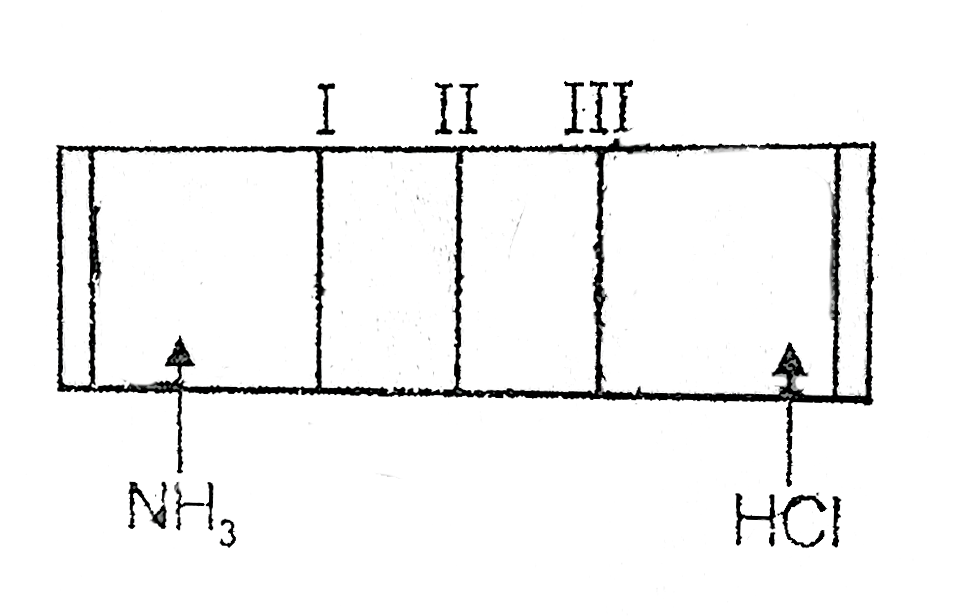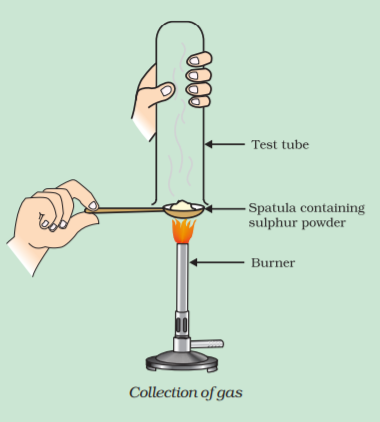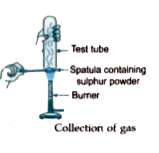Two bits of cottons wool dipped separately in con.HCl and ammonia solution are placed at the ends of a glass tube as shown in the figure.

a) What is the reason for forming thick white fumes-inside the glass tube? b) What happens to the white powder on beating? c) Write the equation for the above reversible reaction.
a) Formation of NH4Cl is the reaction for white fumes.
b) On heating NH4Cl decomposes to form NH3 and HCl
c) NH4Cl(s)↔NH3+HCl(g)
Topper's Solved these Questions
Similar Questions
Roshan took a small amount of hydrochloric acid in a test tube and heated it. He dipped a glass rod in ammonia solution and hold it on the top of the test tube. He observed a white smoke emanating from the tip of the glass rod.
1. What must have happened? Explain.
2. Write balanced chemical equation for the reaction.
3. Name the type of reaction.
View SolutionNo chemical reaction takes place when granules of a rusty brown solid A are mixed with the powder of another solid B. However, when the mixture is heated, a reaction takes place between its components. One of the products C is a metal and settles down in the molten state while the other product D floats over it. It was observed that the reaction is highly exothermic.
(a) What could the solids A and B be ?
(b) What are the products C and D most likely to be ?
(c) Write the chemical equation for the reaction between A and B leading to the formation of C and D.
Mention the physical states of all the reactants and products in this equation and indicate the heat change which takes place.
(d) What is the special name of such a reaction ? State one use of such a reaction.
(e) Name any two types of chemical reaction under which the above reaction can be classified.
View Solution
Knowledge Check
Two pieces of cotton wool soaked separetely in aqueous solution of NH3 and HCl are placed at opposite ends of a close glass tube as shown in diagram

Select nearest position where white solid is formedAIBIICIIIDWhite solid does not formed
A small amount of ferrous sulphate was heated in a hard glass test tube :
(i) Write the equation involved in the above reaction.
(ii) What type of reaction is taking place ?
View SolutionWhen potassium iodide solution is added to a solution of lead (II) nitrate in a test tube, a precipitate is formed.
(a) What is the colour of this precipitate? Name the compound precipitated.
(b) Write the balanced chemical equation for this rection.
(c) List two types of reactions in which this reaction can be placed.
View SolutionWhen potassium iodide solution is added to a solution of lead (II) nitrate in a test tube, a precipitate is formed.
(a) What is the colour of this precipitate? Name the compound precipitated.
(b) Write the balanced chemical equation for this rection.
(c) List two types of reactions in which this reaction can be placed.
View SolutionPratyush took sulphur powder on a spatula and heated it. He collected the gas evolved by inverting a test tube over it, as shown in figure below

(a) What will be the action of gas on
(i) dry litmus paper ?
(ii) moist litmus paper ?
(b) Write a balanced chemical equation for the reaction taking place.
View SolutionPratyush took sulphur powder on a spatula and heated it. He collected the gas evolved by inverting a test tube over it, as shown in figure below.

(a) What will be the action of gas on
(i) dry litmus paper?
(ii) moist litmus paper?
(b) Write a balanced chemical equation for the reaction taking place.
View SolutionPratyush took sulphur powder on a spatula and heated it. He collected the gas evolved by inverting a test tube over it, as shown in figure below.

(a) What will be the action of gas on
(i) dry litmus paper?
(ii) moist litmus paper?
(b) Write a balanced chemical equation for the reaction taking place.
View SolutionPratyush took sulphur powder on a spatula and heated it. He collected the gas evolved by inverting a test tube over it as shown in Fig. below : (a) What will be the action of gas on (i) dry litmus paper ? (ii) moist litmus paper ?
(b) Write a balanced chemical equation for the reaction taking place

View Solution
